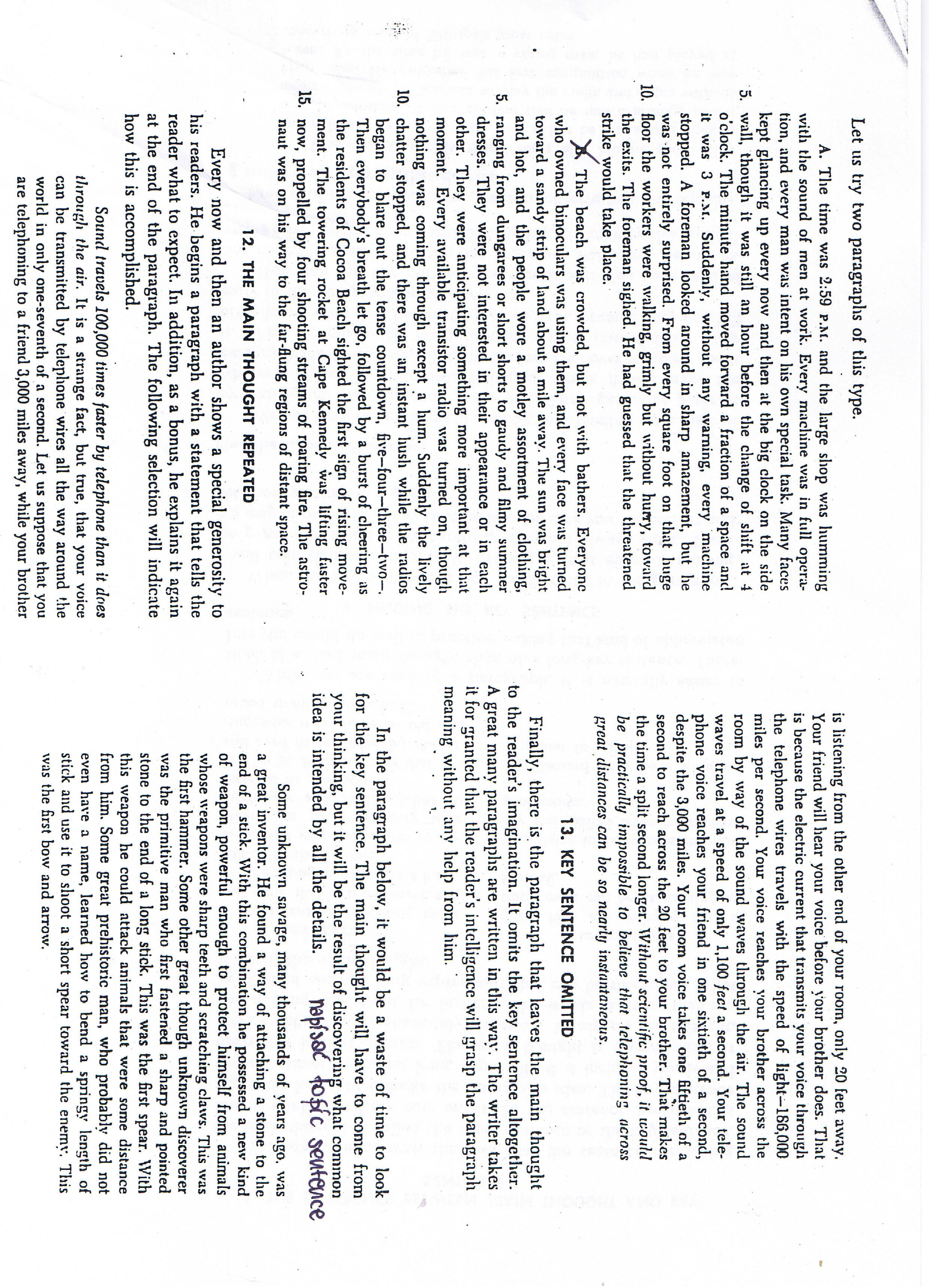CCF20091103�000

Let us try two paragraphs of tliis type.
A. The time was 2:59 p.m. and the large shop was lnimming witli tlie sound of men at work. Every machinę was in fuli opera-tion, and every man was intent on his own special task. Many faces kept glancing up every now and then at the big clock on the side 5. wali, though it was still an hour before the change of shift at 4 oclock. The minutę hand moved forward a fraction of a space and it was 3 p.m. Suddenly, without any waming, every machinę stopped. A foreman looked around in sliarp amazement, but he was not entirely surprised. From every sąuare foot on that lingę 10. floor the workers were walking, grimly but without hurry, toward the e.\its. The foreman sighed. He had guessed that the threatened strike would take place.
The beach was crowded, but not with bathers. Everyonc who owned binoculars was using them, and everv face was turned toward a sandy strip of land about a mile away. The sun was bright and hot, and the people wore a motley assortment of clothing,
5. ranging from dungarees or short shorts to gaudy and filmy summer dresses. They were not interested in their appearance or in each other. They were anticipating something morę important at that moment. Every available transistor radio was turned on, though nothing was coming through except a hum. Suddenly the lively 10. chatter stopped, and there was an instant hush while the radios began to blare out the tense countdown, five-four—three—two—. Then evcrybody's breath let go, followed by a burst of cheering as the residents of Cocoa Beach sighted the first sign of rising move-ment. The towering rocket at Cape Kennedy was lifting faster 15. now, propelled by four shooting streams of roaring fire. The astro-naut was on his way to the far-flung regions of distant space.
12. THE MAIN THOUGHT REPEATED
Every now and then an author shows a special generosity to his readers. He begins a paragraph with a statement that tells the reader what to expect. In addition, as a bonus, he explains it again at the end of the paragraph. The following selection will indicate how this is accomplished.
Sound traoels 100,000 times faster by telephone than it does ilirougli the air. It is a strange fact, but true, that your voice can be transmitted by telephone wires all the way around the world in only one-seventh of a second. Let us suppose that you are telephoning to a friend 3,000 miles away, while your brother
is listening from the other end of your room, only 20 feet away.
Your friend will hear your voice before your brother does. That is because the electric current that transmits your voice througli the telephone wires travels with the speed of light—166,000 miles per second. Your voice reaches your brother across the room by way of the sound waves througli the air. The sound waves travel at a speed of only 1,100 feet a second. Your telephone voice reaches your friend in one sistieth of a second, despite the 3,000 miles. Your room voice takes one fiftieth of a second to reach across the 20 feet to your brother. That makes the time a split second longer. Wif/iouf scicntific proof, it icouhl be practicalhj impossible to belicoc that telcphoning, across prcat clisiances can be so ncarltj instantaueous.
13. KEY SENTENCE OMITTED
Finally, there is the paragraph that lcaves the main thought to the readers imagination. It omits the key sentence altogether. A great many paragraphs are written in this way. The writer takes it for granted that the readers intclligcnce will grasp the paragraph
meaning without any help from him.
• • 1.
In the paragraph below, it would be a waste of time to look for the key sentence. The main thought will have to come from your thinking, but it will be the result of discovering what connnon idea is intended by all the details.
Some unknown savage, many thousands of years ago. was a great inventor. He found a way of attaching a stone to the end of a stick. With this combination he possessed a new kind of weapon, powerful enough to protect himself from animals whose weapons were sharp teeth and scratching claws. This was the first hammer. Some other great though unknown discoverer was the primitive man who first fastened a sharp and pointed stone to the end of a long stick, This was the first spear. With this weapon he could attack animals that were some distance from him. Some great prehistorie man, who probablv did not even have a name, learned how to bend a springy length of stick and use it to slioot a short spear toward the enemy. This was the first bow and arrow.
Wyszukiwarka
Podobne podstrony:
CCF20091103�000 Let us try two paragraphs of this type. A. The time was 2:59 p.m. and the large shop
ZDIĘCIA0084 Computer crime 1 Ouickly read the first two paragraphs of the text. What w Sven )aschan
htdctmw 130 Now let s analyze two morę typical panels through the use of simplified diagrams. In the
Subsystems and network elements in GSM Let us now have a closer look at each of the individual netwo
ussians stress ecking the hallsCome In - Let Us Dernonsłrate i Donna Kankel aff Hrtter Unlike che pe
73emissions20 Let us explain the warranty ... The Emission Control System Warranty of 5 years or 50,
00449 ?6b2c81a17b7f60430d45ea04acefc6 454 Russell Figurę 13. This univariate phase map movie extrac
kolibry w malwach (3) 3ymowL lisi CROSS STITCHUse two strands of the following colors. g; — Lt. Pink
2.2.3 Primary and secondary services There are two classes of allocation shown in the following Tabl
Paradiddle Power 6 Part 5: Jazz Fills With Triple Paradiddles In Triplets Here again, notę that only
więcej podobnych podstron